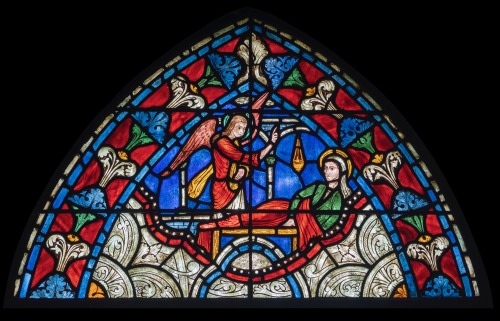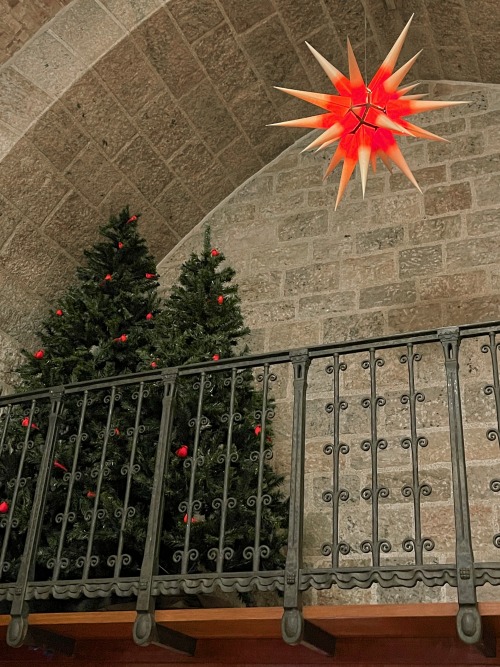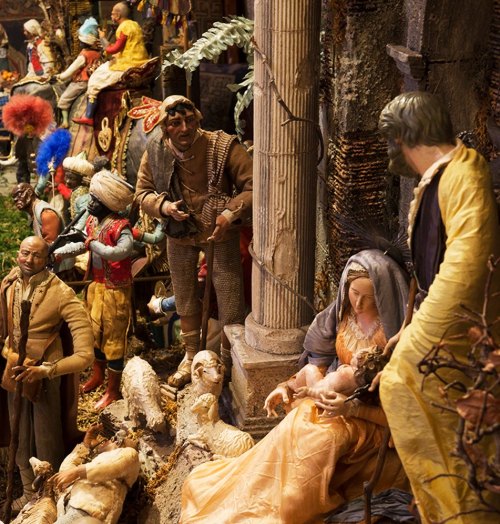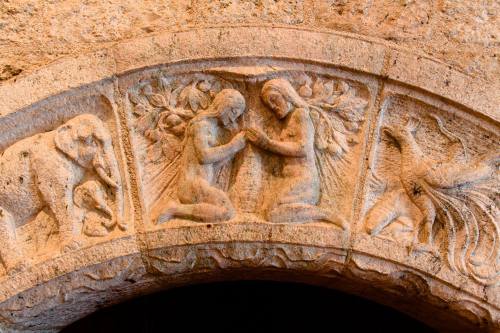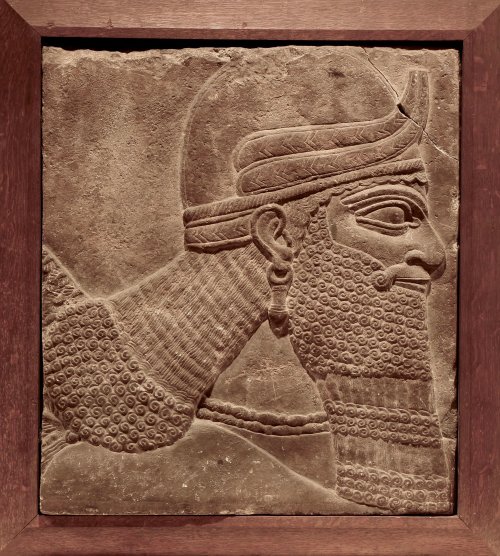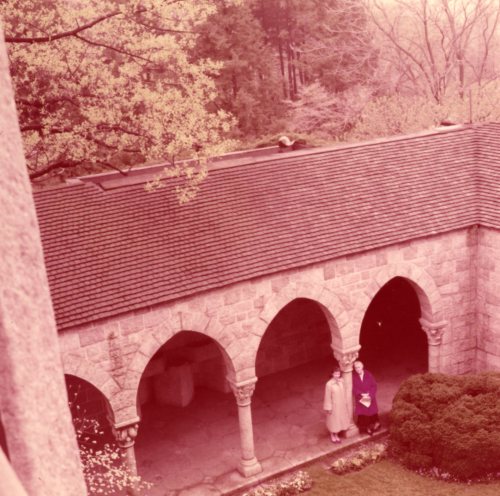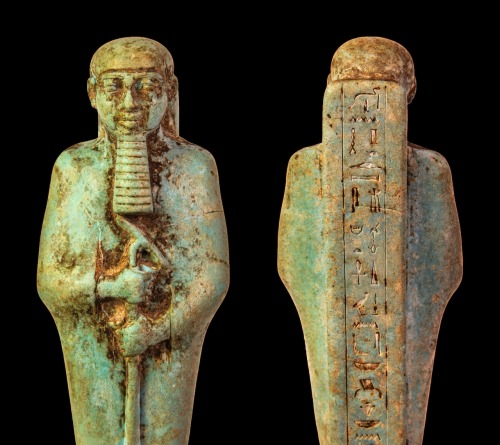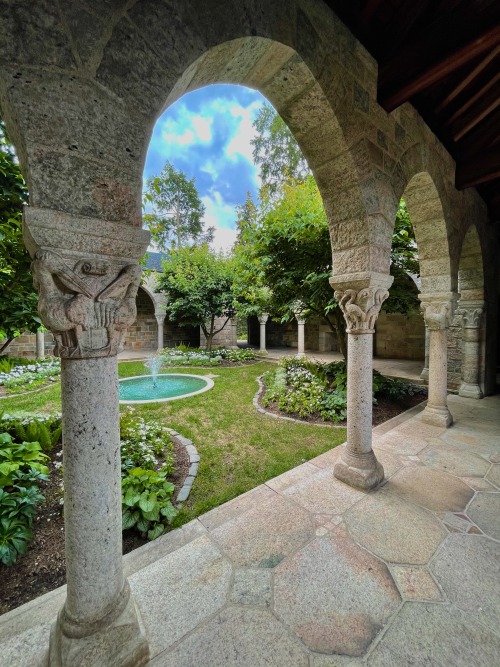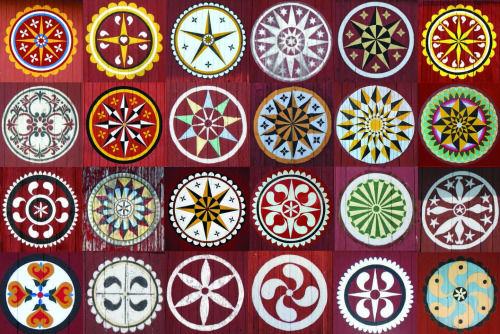#glencairn museum
ADVENT CALENDAR DAY 5
Page from a 15th-century Book of Hours, likely made in Northeast France. Glencairn Museum, Bryn Athyn, PA, 07.MS.639.
This scene of the Wise Men presenting their gifts to the Christ Child is from a page in a 15th-century Flemish medieval prayer book known as the Book of Hours. These personal prayer books contained devotions appropriate for the eight canonical hours of the day, as well as other prayers and texts. According to the Gospel of Matthew, “And when they had come into the house, they saw the young Child with Mary His mother, and fell down and worshiped Him. And when they had opened their treasures, they presented gifts to Him: gold, frankincense, and myrrh” (2:11).
Here the gifts of the Wise Men take the form of three golden chalices. Both the Christ Child, who sits on Mary’s lap, and Mary herself, have haloes, but the infant Christ’s halo incorporates the sign of the cross. The clothing of the Wise Men suggests that they have come from three different of countries, while their hair and beards suggest three different ages: youth, adult, and old age. In the left-hand border of the page, two hounds are depicted chasing a white rabbit. Below the main scene is a peacock.
Every day, from December 1 through December 25, a new work of Nativity art from the Glencairn Museum collection will appear on the home page of our Advent calendar (Follow the Star: A 2021 Advent Calendar). To receive these in your newsfeed, follow our social media (Facebook, Instagram, Twitter, Tumblr).
Post link
ADVENT CALENDAR DAY 4
Stained-glass panel by Winfred S. Hyatt and Lawrence Saint from the Christmas window in Glencairn’s Chapel. The window was made from 1928 to 1956. Glencairn Museum, Bryn Athyn, PA.
This stained-glass panel, made in the Bryn Athyn glassworks, depicts the visit of the Wise Men (sometimes called Magi) to the infant Jesus, with the Star of Bethlehem shining above. According to the Gospel of Matthew, “When they saw the star, they rejoiced exceedingly with great joy; and going into the house they saw the child with Mary his mother, and they fell down and worshiped him. Then, opening their treasures, they offered him gifts, gold and frankincense and myrrh” (2:9–12). This scene is in the Christmas window on the south wall of Glencairn’s Chapel.
The meaning of the term Magi (in Greek magoi) in the context of Matthew’s narrative has been a topic of discussion since the early days of the Christian Church. They have been variously described as “sages,” “diviners,” “astrologers,” or “priests.” As early as the third century, however, some interpreters of the Bible began to identify the Wise Men as kings, in connection with a prophesy found in the Book of Psalms in the Hebrew Bible: “May the kings of Tarshish and of the isles render him tribute, may the kings of Sheba and Seba bring gifts!” (Psalm 72:10). By the time of the Middle Ages, the “three kings” were being depicted in art with crowns and elaborate garments.
Every day, from December 1 through December 25, a new work of Nativity art from the Glencairn Museum collection will appear on the home page of our Advent calendar (Follow the Star: A 2021 Advent Calendar). To receive these in your newsfeed, follow our social media (Facebook, Instagram, Twitter, Tumblr).
Post link
ADVENT CALENDAR DAY 3
Stone with polychromy, made in France during the late 15th-century. Glencairn Museum, Bryn Athyn, PA, 09.SP.83.
According to the Gospel of Luke (1:39–56), after the angel Gabriel told Mary that she would give birth to Jesus, the Son of God, she traveled to visit her cousin Elizabeth. This event is commonly called the Visitation. In this 15th-century sculpture group from France, Mary (left), who is pregnant with Jesus, holds a rosary, a set of prayer beads often seen in medieval art. Elizabeth, who is pregnant with John the Baptist, touches her cousin’s womb. According to Luke, when Elizabeth heard the greeting of Mary she was filled with the Holy Spirit, and proclaimed, “Blessed are you among women, and blessed is the fruit of your womb!” (1:42). This sculptural group may have been made for a private chapel dedicated to either Saint Elizabeth or Saint John the Baptist.
Every day, from December 1 through December 25, a new work of Nativity art from the Glencairn Museum collection will appear on our website (Follow the Star: A 2021 Advent Calendar. To receive these in your newsfeed, follow the Museum’s social media (Facebook, Instagram, Twitter, Tumblr).
Post link
ADVENT CALENDAR DAY TWO
Stained-glass panel by Winfred S. Hyatt from the Christmas window in Glencairn’s Chapel in Bryn Athyn, PA. The window was made by Lawrence Saint and Winfred Hyatt from 1928 to 1956. Glencairn Museum, Bryn Athyn, PA.
This stained-glass panel, made in the Bryn Athyn glassworks, depicts the moment when the angel Gabriel announces to Mary, who is resting on a bed indoors, that she has been chosen to be the mother of Jesus Christ. According to the Gospel of Luke, the angel said, “Behold, you will conceive in your womb and bring forth a Son, and shall call His name Jesus” (1:31). The scene is at the top of the Christmas window on the south wall of Glencairn’s Chapel. While the lower scenes in this window were copied from the original 13th-century church of Sainte-Radegonde outside the city of Poitiers, France, this Annunciation seems to have been designed by Bryn Athyn artist Winfred S. Hyatt. (An Annunciation scene has not survived from the window at Sainte-Radegonde.)
Every day, from December 1 through December 25, a new work of Nativity art from the Glencairn Museum collection will appear on our website (Follow the Star: A 2021 Advent Calendar). To receive these in your newsfeed, follow the Museum’s social media (Facebook, Instagram, Twitter, Tumblr).
Post link
ADVENT CALENDAR DAY ONE
Fresco by an unknown artist from the Clarissan monastery of Santa Maria inter Angelos, near Spoleto, Italy (c. 1300). Glencairn Museum, Bryn Athyn, PA, 08.FS.07.
The story of the Annunciation to Mary comes from the Gospel of Luke (1:26–38), in which the angel Gabriel appears to Mary and informs her that she will give birth to Jesus, the Son of God. This large, 13th-century Italian fresco in Glencairn’s Great Hall depicts the moment when Gabriel delivers this astonishing news. The angel says to her, “Do not be afraid, Mary, for you have found favor with God. And behold, you will conceive in your womb and bring forth a Son, and shall call His name Jesus.” (Luke 1:30–31). Gabriel, on the right with wings and a halo, walks toward Mary with his hands in a gesture of blessing. Mary, also wearing a halo, inclines her head, which is covered with a cloak, to Gabriel.
Every day, from December 1 through December 25, a new work of Nativity art from the Glencairn Museum collection will appear on our website (Follow the Star: A 2021 Advent Calendar). To receive these in your newsfeed, follow the Museum’s social media (Facebook, Instagram, Twitter, Tumblr).
Post link
According to tradition, a Moravian Star should be displayed beginning on the first Sunday in Advent (the fourth Sunday before Christmas) until Epiphany (January 6). The Herrnhut Star Company in Herrnhut, East Saxony, Germany, has been producing Moravian Stars for over 160 years. The star on exhibit in Glencairn’s Upper Hall was originally given as a gift to Oskar Boehm by his sister Erna Pfueller (née Boehm). Oskar, his wife Anna, and their children had immigrated from Germany’s Erzgebirge region to the United States in 1928. Edna remained in Germany, and following World War II the region where she lived became part of the German Democratic Republic (East Germany). In the 1950s Erna mailed the star from Germany to Oskar’s family as a gift. Oskar worked as a sexton for St. James Methodist Church on Tabor Road in Philadelphia, and for many years it was displayed in that church at Christmastime. (Gift of Helmut and Elfriede Boehm)
Check out this year’s “Christmas at Glencairn” events here: https://bit.ly/ChristmasAtGlencairn
Post link
The 100+ figures in this large 19th- and 20th-century Presepio were collected in Italy over a period of more than thirty years by the late Elizabeth Anne Evans of Bucks County. A Presepio, which has been called “the translation of the Bible into Neapolitan dialect,” represents daily life in 18th-century Naples, a bustling port city. The miracle of the Nativity is depicted as taking place amid crumbling Roman ruins, signifying the end of the old Roman world and the dawn of Christianity. (Suggested donation to Glencairn’s World Nativities” exhibition is $5.) https://bit.ly/ChristmasAtGlencairn
Post link
Happy Thanksgiving! We give thanks for the artists, craftsmen, designers, and architects—past and present—whose creations inspire us and enrich our lives.
Post link
We made an interesting discovery yesterday. It’s hard to see it without magnification, but this wooden carpenter’s mallet in the Glencairn collection is stamped with the name “J. McMillan.” We know very little about James McMillan, but we have now learned from public records and a Glencairn payroll document that he worked for Raymond Pitcairn at Bryn Athyn Cathedral and Glencairn from 1918 (possibly earlier) until 1941. He was born in County Antrim, Ireland, in 1882, and lived in the Philadelphia area until he died in 1944. He is listed as a carpenter. If by any chance James McMillan is a relative of yours, or if you know anything about him, please get in touch with us—we’d love to learn more!
Post link
Collected by Raymond Pitcairn during the 1920s, the Assyrian reliefs in Glencairn’s Ancient Near East gallery are “an exceptionally well-chosen group, representing diverse aspects of the religion, ideology, and artistry of the Assyrian Empire and typifying the development of the genre over time” (Eva Miller, University of Oxford). In this 2016 essay for Glencairn Museum News, Eva Miller examines the meaning of the images in these reliefs and how they have been received in both ancient and modern times: https://bit.ly/2D19XKF
Post link
This strange-looking device, located in the small pantry between Glencairn’s kitchen and dining room, is a roll-top Hobart dishwasher (we think it’s a model SM-6T2). Made by the Hobart Manufacturing Co, Troy, Ohio, it was designed for small loads, and could sometimes be found in diners and church kitchens.
Post link
Apparently it’s National #StickOutYourTongueDay! Like many other lighthearted social media holidays, the origin of this day is unknown, but it gives us a good excuse to show you this cheeky sculpture. Images of lions were popular in medieval art, and it was believed that they could help to ward off evil. Read more in “Protective Images from Glencairn’s Medieval Sculpture Collection,” a 2017 article in Glencairn Museum News:https://bit.ly/3axZ0gj
Post link
The fantastic creatures carved on this fragment of a medieval baptismal font in Glencairn’s collection may have been intended to ward off evil during the ceremony of baptism. According to Dr. Julia Perratore, “medieval baptismal fonts were frequently endowed with an extra layer of spiritual protection in the form of apotropaic imagery. Romanesque fonts in particular tend to display images of frightening monsters and violent confrontations between beasts (or humans and beasts) because physical struggle was seen as an appropriate metaphor for the vanquishing of evil through baptism.” Read more about this and other “monsters” in Glencairn in “Protective Images from Glencairn’s Medieval Sculpture Collection,” a 2017 article in Glencairn Museum News:https://bit.ly/3axZ0gj
Post link
Is it really #WorldEmojiDay again already? I can hardly it! Were ancient Egyptian hieroglyphs similar to modern emojis? In some ways, yes. There are over 700 different hieroglyphs. Some of them, like emojis, stand for the objects they represent (ideograms). Others stand for sounds or syllables (phonograms). Were there rules of grammar? Absolutely! For example, word order in Egyptian is verb-subject-object. And some things never change—there were “spelling police” back then, too! Check out this student’s writing board in The Met collection (https://bit.ly/3xIV0o6).
Post link
Joyce Bellinger and Mildred Pitcairn in Glencairn’s cloister (1957). Beginning in 1947 Bellinger, originally from Canada, lived and worked at Glencairn while attending Bryn Athyn College. Within a few years she became Glencairn’s full-time housekeeper and Mildred Pitcairn’s personal assistant.
Post link
Where did we come from and how did our world begin? For thousands of years, people from cultures all around the globe have devised stories to explain the creation of their domains. In this essay for Glencairn Museum News, Dr. Jennifer Houser Wegner, Associate Curator in the Egyptian Section at the Penn Museum, introduces us to the fascinating subject of ancient Egyptian creation myths, including the cosmological context for a number of objects in Glencairn Museum’s Egyptian gallery.
Post link
In another day or two we’ll be ready to publish an article in Glencairn Museum News about Egyptian creation myths. This hieroglyphic inscription is on the back pillar of a figurine in the Glencairn collection of Ptah, a creator god. The inscription includes three hieroglyphs which, when combined, form the word “hemut,” which can be translated as “craftsmanship.” The ancient Egyptians didn’t have a word for “art,” but they recognized the output of craftsmen as a form of creation!
Post link
Today is #BarnDay! Celebrate by driving out to the country to see as many barns as you can. If you live in Southeastern Pennsylvania, keep an eye out for barn stars (also known as “hex signs”). Did you know that the full text of the catalog from Glencairn’s 2019 exhibition, Hex Signs: Sacred and Celestial Symbolism in Pennsylvania Dutch Barn Stars, is available online for FREE? You can either read it online or download it as a PDF file here: https://bit.ly/2Cp1ocy
Post link




